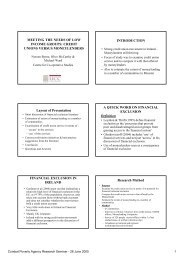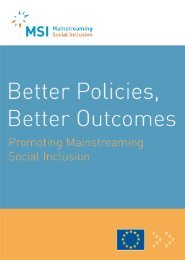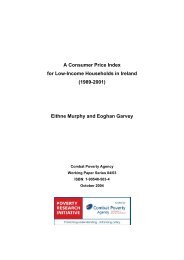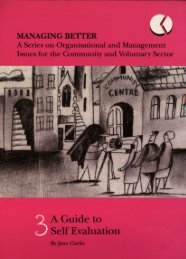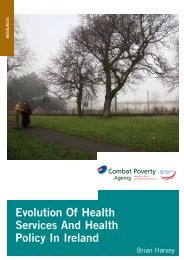Planning for a More Inclusive Society - Combat Poverty Agency
Planning for a More Inclusive Society - Combat Poverty Agency
Planning for a More Inclusive Society - Combat Poverty Agency
You also want an ePaper? Increase the reach of your titles
YUMPU automatically turns print PDFs into web optimized ePapers that Google loves.
pre-budget submissions and its submissions on thenational agreements.The <strong>Agency</strong> has developed an evaluation frameworkwhich has been endorsed by NAPS IDPC and this initialassessment has now been produced, drawing on theviews of key players involved in the development andimplementation of NAPS.The <strong>Agency</strong> has a remit to include consideration of theviews and experience of the community and voluntarysector. The <strong>Agency</strong> provides core funding and has anongoing relationship with the seven National Anti-<strong>Poverty</strong> Networks: the lrish National Organisation <strong>for</strong> theUnemployed (INOU); the Community Workers' Co-operative (CWC); the lrish Rural Link (IRL); the EuropeanAnti-<strong>Poverty</strong> Network (EAPN); the Forum of People withDisabilities (Forum); the lrish Travellers Movement (ITM)and the One-Parent Exchange Network (OPEN). The<strong>Agency</strong> has regular meetings with the National Anti-<strong>Poverty</strong> Networks. At these meetings NAPS is often akey item on the agenda.The <strong>Agency</strong> liaises with the broader community andvoluntary sector in a number of ways. These include:its grant scheme;its involvement in the development of the WhitePaper on relations between the community andvoluntary sector and the state;advislng the Department of Soclal, Community andFamily Affa~rs on its Community DevelopmentProgramme;lnfluenclng government policy and practice ond~alogue with, and inclusion of, the community andvoluntary sector In policy making, with particularregard to NAPS;developing programmes on influencing policy;~ts drugs policy programme;supporting representat~on of the community andvoluntary sector on key national <strong>for</strong>a;~ts local government work;through the Peace and Reconctliation Programme;through the Demonstration Programme onEducational Dlsadvantage;through ~ts work on tackl~ng chtld poverty.To help In<strong>for</strong>m the development of constructiverelat~onshlps w~th the commun~ty and voluntary sector Inthe ~rnplementatlon of NAPS, research wascommlss~oned by the <strong>Agency</strong> to explore models of qoodpractlce draw~ng from ~nternatlonal and EuropeanexperienceSeveral useful lessons <strong>for</strong> anti-povertystrategies can be drawn from the internationale~perience.~ These are:a clear distinction needs to be made at the openingof any consultation between: (i) broad open dialoguewith NGOs in general, (ii) building conditions <strong>for</strong>consultations with NGOs on specific issues, and (iii)undertaking more restricted negotiation;differences in treatment of large charitable bodies,foundations and associations, on the one hand, andsmaller voluntary and community groups on theother, should be made transparent to all parties inthe consultation process;confidence-building measures <strong>for</strong> the voluntary andcommunity sector are useful. This is often related toweak resourcing of the voluntary sector's investmentin explaining policy changes to its members oraffiliates.This research report resulted in a successful applicationto the EU to undertake a project to develop guidelines<strong>for</strong> the involvement of excluded persons and theorganisations which represent them in the development,implementation and evaluation of social inclusion andanti-poverty strategies, as mentioned in Chapter 2 of thisreport. This is a transnational project involving partnersfrom Finland, Northern Ireland, the Netherlands andPortugal. At a national level the project is led by the<strong>Combat</strong> <strong>Poverty</strong> <strong>Agency</strong>, in partnership with NAPS Unitand the National Anti-<strong>Poverty</strong> Networks.The <strong>Agency</strong> was also to provide in<strong>for</strong>mation andeducation material. Material on NAPS <strong>for</strong> publiceducation and awareness purposes has been publishedregularly by the <strong>Agency</strong>, indeed it has been one of themain sources of public in<strong>for</strong>mation on NAPS and NAPScritiques. For further details on this element of the<strong>Agency</strong>'s work, see Chapter 8. The <strong>Agency</strong> has alsocontributed to the initial training of liaison officers,organised by NAPS Unit.2.R The Community and VotuntarySectorThe voluntary and community sector had a key role toplay In the development of NAPS. It was envisaged thatthis role, <strong>for</strong> the community and voluntary sector, andother key actors such as the social partners and users ofservices, would continue and develop. Since the launchof NAPS the involvement of the community andvoluntary sector in the ~rnplementation of the Strategyhas been limited. The Nat~onal Anti-<strong>Poverty</strong> Networkshave had meetlngs with the NAPS Un~t, but these havema~nly taken the <strong>for</strong>m of In<strong>for</strong>mation exchange rather5 Ralaheen Ltd and Commun~ty Techn~cal Aid (1998), Models of Con sultaf~on and Ongorng Pamopahon between the Statutory Sector and theCornmcinrty and Voluntary Sector to In<strong>for</strong>m the Implernentat~on of the Natronal Antf-<strong>Poverty</strong> Strategy (NAPS) Dublin: <strong>Combat</strong> <strong>Poverty</strong> <strong>Agency</strong>6 Spe Conroy P (19991 "lnrernatlonal Models <strong>for</strong> Tackl~ng <strong>Poverty</strong>" IV I <strong>Poverty</strong> Today AprrllMay 1999, No. 43, Dublin- <strong>Combat</strong> <strong>Poverty</strong> <strong>Agency</strong>than consultation or joint initiatives. Some groups havehad the opportunity to meet with NAPS IDPC onparticular initiatives, but these opportunities have beenlimited to a few occasions. Members of the communityand voluntary sector, and the social partners have beeninvolved in the development of poverty proofing throughPartnership 2000. In addition, community and voluntarysector representatives have contributed to two NAPS-ledcross-departmental initiatives on Literacy <strong>for</strong> the Long-Term Unemployed and Homelessness. Further details onthese initiatives are contained in Chapter 7.Over the last two years the Department of Social,Community and Family Affairs has been preparing aWhite Paper on the community and voluntary sector andits relationship with the State. A Green Paper,Supporting Voluntary Activity was published in 1997,followed by a consultation process. A Steering Group,including representatives from the community andvoluntary sector, was set up to advise on the preparationof a White Paper on the basis of the consultations. TheWhite Paper is currently in preparation.' It is envisagedthat the White Paper will outline principles and goodpractice models in relation to consultation between thecommunity and voluntary sector and the state. It is alsohoped that the White Paper will contribute to improvedconsultation mechanisms in the context of NAPS.In the context of the White Paper, and of NAPS, it isimportant to recognise the range and diversity ofcommunity and voluntary sector players who have animportant contribution to make. A number of umbrellabodies and networks have a central role to play in theoverall development of the voluntary and communitysector. They can provide support, training, in<strong>for</strong>mationand other developmental services <strong>for</strong> their affiliatedorganisations as well as a policy <strong>for</strong>mation and liaison role.These umbrella bodies include: the National Anti-<strong>Poverty</strong>Networks (see section 2.7) and the Community Plat<strong>for</strong>m.The Community Plat<strong>for</strong>m represents a wide range ofnational community and voluntary organisations with ananti-poverty focus which have come together as a result oftheir need <strong>for</strong> representation and a negotiating voice indiscussions on the national agreements. The CommunityPlat<strong>for</strong>m is one of eight groups involved In the CommunityPillar, which itself has been involved in negotiating the lasttwo national agreements. Another recent development ISthe emergence of the "Wheel". This is a movement <strong>for</strong>groups and individuals who wish to explore ways andmeans in which the community and voluntary sector m~ghtcome together in a more cohesive and meaningful way. Itis not a volce <strong>for</strong> the sector but alms to act as a catalystbehind many volces with~n the sector.In undertaking consultation on NAPS Issues it will beImportant to recognise the range of players involved andtheir status, and to use different mechanisms <strong>for</strong>different consultations. In other words, the focus shouldbe on how to organise consultations and involvementmore effectively within the range of existing structures.This is particularly pertinent in relation to engaging thecommunity and voluntary sector in the process of settingNAPS targets and the review and evaluation of NAPS.2.9 Local and Regional GovernmentRe<strong>for</strong>m of local government has been ongoing <strong>for</strong> anumber of years. One aspect of this re<strong>for</strong>m is that localauthorities are to have an enhanced role in strategiceconomic and social planning and thereby promotinggreater co-ordination in the delivery of public services intheir areas. Key in this development will be theCountylCity Development Boards (CDBs) who will bringtogether local government, local development, the stateagencies active at local level, and the social partners,including the community and voluntary sector.The Boards will have two main functions:(i) to increase co-operation between members,including enhanced in<strong>for</strong>mation flow;(ii) to work on an agreed countylcity strategy oneconomic, social and cultural development which isto be in place by 2002.The CDBs will be supported by new Directors ofCommunity and Enterprise who have recently beenappointed in the 34 countylcity councils (NESF, 1999).In 1998, a system of policy-focused Strateg~c PolicyCommittees (SPCs) replaced the tradit~onalocalauthority committee structure. They are made up ofelected councillors and other representatlves from thesocial partners and sectoral Interests. A Task Force onthe Integration of Local Government and LocalDevelopment Systems, which was set up in June 1998reported In August 1998. Th~s Task Force report hasbeen adopted as government pol~cy. The Task Force ISnow overseeing the lmplementatlon of the lntegratlon oflocal government and local development and has Issueda gu~dance document ent~tled Preparing the Ground:Guidelines <strong>for</strong> the Progress from Strategy Groups toCountylCity Development Boards (Department ofEnv~ronment and Local Government, 1999).Guldellnes <strong>for</strong> preparing cltylcounty d~velopmentstrateg~es have been agreed by the Department of theEnv~ronment and Local Government The Gu~del~nesh~ghllghthe Importance of lnclud~ng an antl-povertydlmens~on In the strategies7 The new partnership agreement Programme <strong>for</strong> Prosperrty and Farrness states that A Wh~te Paper on Relat~ons betw~en the Cornmunitv andVoluntary Sector and the State will be publ~shed ~n April 2000" 4 1Andnltial Assessment of the-*Ja?iarlai Anti-<strong>Poverty</strong>_S+ra+egy_ part 2




